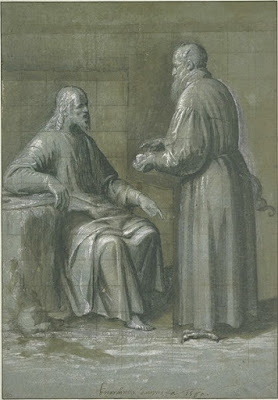 |
| Jan van Somer Boy delivering a Letter to a Woman in her Chamber before 1699 mezzotint Rijksmuseum, Amsterdam |
 |
| James Sant A Thorn amidst the Roses 1887 oil on canvas Manchester Art Gallery |
 |
| Francisco Rizi The Dream of St Joseph ca. 1665 oil on canvas Indianapolis Museum of Art |
 |
| Pierre-Paul Prud'hon The First Kiss (illustration for La Nouvelle Héloïse by Jean-Jacques Rousseau) ca. 1792-99 drawing (print study) Musée du Louvre |
 |
| Bernardino Luini Child playing with a Sheep before 1532 drawing Musée du Louvre |
 |
| Edmund Leighton On the Threshold 1900 oil on canvas Manchester Art Gallery |
 |
| Mabel Frances Layng Mars and Venus ca. 1918 oil on canvas Nuneaton Museum and Art Gallery, Warwickshire |
 |
| Gaetano Lapis Baptism of Clorinda (scene from Gerusalemme Liberata by Torquato Tasso) before 1776 oil on canvas Galleria Nazionale delle Marche, Urbino |
 |
| Johann Heinrich von Hurter Angelica and Medoro (scene from Orlando Furioso by Ludovico Ariosto) 1769 enamel miniature Musée du Louvre |
 |
| Francisco Henrique Madonna of the Snow ca. 1508-1512 oil on panel Museu Nacional de Arte Antiga, Lisbon |
 |
| William Hamilton Celadon and Amelia (scene from The Seasons by James Thomson) 1793 oil on canvas Detroit Institute of Arts |
 |
| Ercole Graziani the Younger Return of the Prodigal Son ca. 1730 oil on canvas Collection of Franco Maria Ricci, Fontanellato |
 |
| Henry Fuseli The Nightmare 1781 oil on canvas Detroit Institute of Arts |
 |
| Honoré Daumier Two Lawyers Conversing ca. 1860 drawing, with gouache Morgan Library, New York |
 |
| Bernardino Campi Temptation of Christ 1580 drawing (design for lost fresco) Musée du Louvre |
 |
| Ford Madox Brown Christ washing the Feet of St Peter ca. 1852-56 oil on canvas Tate Britain |
 |
| Pietro della Vecchia Doubting Thomas ca. 1670 oil on canvas Palazzo Thiene, Vicenza |
– Intuition is the attendant of genius; gradual development that of talent.
– Taste is the legitimate offspring of nature, educated by propriety; fashion is the bastard of vanity, dressed by art.
– Taste sheds a ray over the homeliest or the most uncouth subject; fashion frequently flattens the elegant, the gentle, and the great, into one lumpy mass of disgust.
– Tone is the moral part of colour.
– Love for what is called deception in painting, marks either the infancy or the decrepitude of a nation's taste.
– The fewer the traces that appear of the means by which any work has been produced, the more it resembles the operations of Nature, and the nearer it is to sublimity.
– Beauty alone, fades to insipidity; and like possession cloys.
– Henry Fuseli, from Aphorisms on Art (1818)